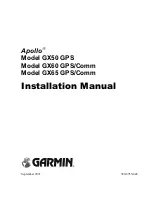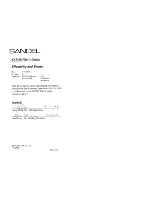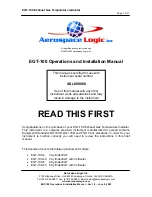
G SERIES PILOT’S GUIDE .
INSIGHT
INSTRUMENT CORPORATION BOX 122, FORT ERIE, ONTARIO, L2A 5M6
27
There are certain times when you should not lean to peak or even attempt to find peak. In full power climb or any time the
engine is operating at power settings in excess of 75%, leaning to peak could result in detonation and serious engine dam-
age. This is especially true for high performance engines and turbocharged aircraft.
Importance of Measuring Turbine Inlet Temperature
The measurement of TIT has become popular in recent years with some aircraft coming so equipped right from the fac-
tory. Although turbine inlet temperature is an invaluable operating parameter, a great deal of confusion still surrounds TIT
indications and their meaning. Turbine inlet temperature is measured by a single probe mounted in the exhaust inlet to the
turbocharger. The TIT display shows the temperature of the exhaust gases that drive the turbo.
In many cases this probe is just a foot or so downstream of all the EGT probes. At first glance this measurement appears
redundant. Why read the temperature again when it is just the collection of all the EGTs?
TIT is not a simple function of the collective exhaust gas temperatures. It may be hotter than the hottest EGT that feeds it
or cooler than the coolest EGT.
The temperature measured by the EGT probe is the average of the pulse of high temperature gases that exit the cylinder
when the exhaust valve opens. The TIT probe sees the collection of pulses from all cylinders that feed it and will indicate a
higher temperature.
Turbo action is throttled by the wastegate valve that forces a portion of the exhaust gases to bypass the turbo.
At low altitude, with little demand for turbo-charging, the wastegate will direct a large part of the exhaust past the turbo and
the TIT probe will read a lower temperature. At higher altitudes the wastegate will close to direct more energy to the turbo
and a higher TIT will be indicated.
TIT is not just a simple function of EGT and this is very important to consider when operating a turbocharged engine.
A power setting and fuel flow that may be well below peak EGT and well below the TIT redline temperature at 9000 ft may
easily exceed the TIT redline at 16000 ft. The higher temperature results from more exhaust gas driving the turbo to restore
the manifold pressure at the higher altitude.
The TIT reading is a key factor in leaning the turbocharged engine. It also provides diagnostic information that is unavailable
from other sources. A wastegate system malfunction will affect TIT readings under conditions where other indications are
normal. Should the wastegate stick closed at high altitude, all indications would appear normal.
Subsequent throttle power reductions for descent would show a deceptively normal decrease in manifold pressure but ab-
normally high TIT readings for that situation. Other factors such as ignition, fuel distribution, induction, or compression that
affect EGT will also affect TIT; sometimes with detrimental results.
For example, ignition failures that cause the EGT to rise may increase the TIT past redline.
Special Considerations for Turbos
Turbocharged engines exhibit some special characteristics that result from the interaction of the turbocharger, throttle, wa-
stegate controller, and other engine components. These interactions will vary in degree depending on the engine type and
installation. In the normally aspirated engine, the components of combustion are essentially fixed for a given throttle and
mixture setting. Any mixture control change results in a direct mixture change.
The turbo has one additional complication that results from mixture changes:
A change in mixture changes the exhaust gas energy that drives the turbo.
This change in turbo drive energy changes the induction or manifold pressure and temperature and may or may not be
compensated for by the turbo wastegate controller.
The turbo also has significant inertia which causes a lag in response to changes in drive energy.
The result of this turbo bootstrapping is a change in the EGT/Fuel Flow Curve depending on the direction of mixture move-
ment. This lag must be understood and taken into consideration to properly lean the engine.
This change in the curve becomes evident if the pilot tries to enrich the mixture to drop the temperature one bar.
In most turbocharged engines it will take considerably more fuel flow to drop the temperature one bar than it did to achieve
that temperature on the way up. For example, in a normally aspirated engine, enriching for a 25 degree drop may take a 1/2
gph increase in fuel flow. The same model engine when turbocharged may require a 2-4 gph increase in fuel flow to get the
same 25 degree drop. Paradoxically, the pilot may even see EGT rise when he starts enriching before it begins to fall.









































